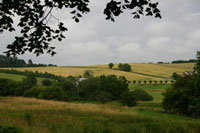



Which Fields are Best for Ag Production?
DENMARK - Should a field be sown with grain for feeding pigs? Or should it be covered with willow for energy? Or dotted with grazing sheep? How a field should be used most sensibly varies when not only regular agricultural factors are taken into consideration but also environmental factors.
(Photo: Janne Hansen)
"Crops for food and feed should be concentrated on robust land. Sensitive land can be used for growing perennial crops for fibre or energy, and growing feed crops in environmentally friendly cropping systems," says senior scientist, Uffe Jørgensen from the Faculty of Agricultural Sciences at Aarhus University. He describes how the Danish farmer can adapt his selection of crops with a special focus on reducing nitrogen leaching.
"Food and feed should primarily be produced in less nitrate sensitive areas. Perhaps the Danish authorities would permit an increase in the level of nitrogen fertilisation, thus increasing yield. For fibre and energy it would be a good idea to choose perennial crops with a very low level of nitrate leaching. They should primarily be located in areas that are nitrate sensitive with regard to surface water and groundwater."
Feed production, especially roughage, should be produced close to the individual livestock farms. On livestock farms that are close to very sensitive areas it is possible to optimise the environmental profile by growing grass and using catch crops as much as possible.
"If the development of efficient catch crop systems in maize and winter grains succeeds, then it would probably be possible to continue growing crops for food, feed, fibre and energy in just about all parts of the country," says Dr Jørgensen.
The level of nitrate leaching from various crops depends primarily on whether the crops are annual or perennial. Leaching from a crop rotation consisting of grain, seeds and crop rotation grass can be 3-4 times greater than from permanent grass or energy willow.
Most food crops are annual while crops for feed, fibre and energy can be either annual or perennial. There are many good reasons to choose perennial plants, particularly with regard to energy crops.
"There will always be certain areas that are not suited for all crop types. This could, for example, be very wet areas. There will probably be an increase in the number of wet areas due to increased rainfall resulting from global warming. In this case it would be a good idea to change from growing grain and seed crops to growing willow, which has a high water uptake and which tolerates humid soil," says Dr Jørgensen.








